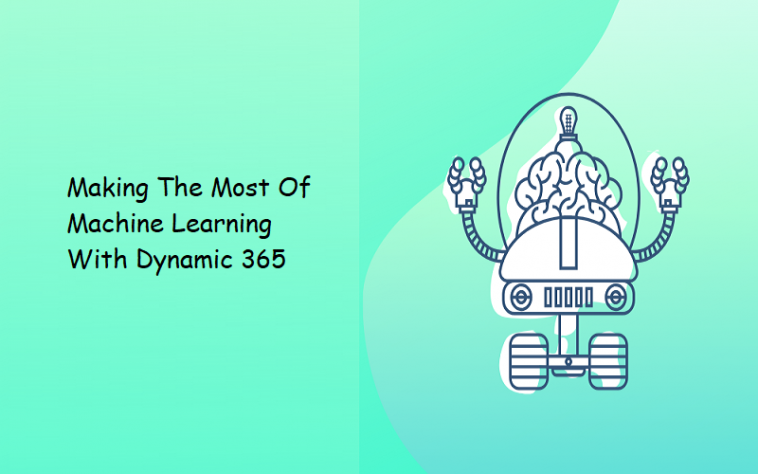However, machine learning as a whole is considered to be a mystic black box. It is not a check box feature, or a feature you can enable and forget. It is a technique, a process that has to be worked upon and evolved. Eventually, it can grow to be the greatest asset your business ever owned, and Dynamics CRM is the perfect tool to get you there.
The basic steps to a great machine learning application would be:
- Data collection: One can gather transactional or historical data using Dynamic 365 for Operations.
- Machine Learning: Azure Machine Learning can be used to predict the future values and forecast the future events based on the collected data.
- Evaluatation: Use Dynamics 365 to evaluate the accuracy of predictions and making changes to the model as per individual needs.
- Authorize Forecast: Use Dynamics 365 to authorize the predicted value.
Azure machine learning, or Microsoft machine learning, is a cloud based solution to predictive analysis. Like any other cloud computing platform, the shared resources are a great way to cut down costs, yet, get a better performing CPU core.
Best practices to Adopt
- Data is important. You must pay attention to the quality and the quantity of data. A machine learning model is basically a tool built on data, and if the foundation goes wrong your model turns out to be useless. The more the quantity of data, the better the machine will learn. The philosophy here is similar to human learning – the more you read, the more you learn. Apart from a large quantity, you have to maintain the quality of the data. Inconsistent, irrelevant and missing data contribute to inaccurate predictions which in turn harm forecasts. You must not forget that the underlying principles are usually regression and regression depends on data.
- Data Transformation/Manipulation. If you somehow land up with patchy data where a few salesmen forgot to fill in the CRM sheets, Microsoft provides you with options to fill it in. In some cases, you can split the data to eliminate such values, in others you can make up new values keeping in mind the mean of the existing values. At some point, you can also use your prediction algorithms to predict these data points – while this is a recursive problem, the results are usually pretty great.
- Over population is a sin. While data is important, integrating multiple sources and over populating the model in the hopes of getting various insights is a bad approach. Your predictions, the model and everything else depends totally on your input data, so you would want to keep it sane. Machine learning makes life easier and is indeed a smart approach towards drawing insights, however, it is not a magic wand that can undo your wrongs.
- Do not use ML for simple tasks. One can easily complicate a simple spreadsheet job by working on it using machine learning. If a human can look at data and work on it on a spreadsheet, there’s no point of training a machine learning model and wasting time, energy and other crucial resources. Complex tasks like predicting the weather do require a machine learning model, but a simple classification job that detects extraterrestrial frequencies does not! While the extraterrestrial frequency detection sounds hi-fi, you can simply look at a frequency and determine if it is below a threshold limit or not and hence classify it. However, weather depends on a lot of factors like the temperature, wind pressure, currents, etc that must be taken into account as well.
Use cases of Machine Learning for an enterprise
Speak to Ryan Chynoweth, a data science consultant at Northwest Cadence, Bellevue, and you will probably understand that at the end of the day, the benefits of a CRM completely depend upon how the enterprise uses the CRM, and its machine learning abilities.
Sales closures
A great example would be to track sales closures. Here, the ML model can predict the number of people who have a likelihood of actually buying the product after a sales call. However, the problem in the present day scenario is that salesmen often enter the number of people, who have already bought a product and expect to train a model on this data alone. This is not possible. CRM worksheets should be used judiciously. Entering responses to help asses the salesman, the customer, demographics, and the like prove to be helpful when predicting the future possibilities. You can also fine tune your sales mechanisms according to insights gleaned from the machine learning models.
Predicting fluctuation in prices
Petrol prices, airline tickets, real estate prices, etc. keep fluctuating over time. Azure ML models can be used to predict them, provided we have enough data at hand. For example Stefano Tempesta, VP of Engineering at EF Education First and a Microsoft MVP, has spoken at length about the model he trained to predict airline ticket fluctuations based on airline routes, sales data, prices from the websites, and other high-end data.
These were just a couple of the millions of use cases machine learning has. Evidently, Machine Learning is changing the way we see sales and use customer resource management resources. From reducing churn rates to increasing productivity, ML is now an indispensable factor in our lives and Microsoft dynamics CRM development services has embraced this technology with open arms in a pretty commendable manner.



Comments
0 comments